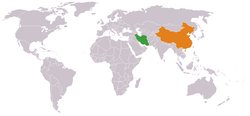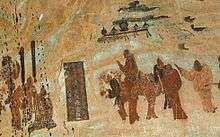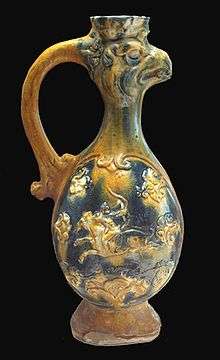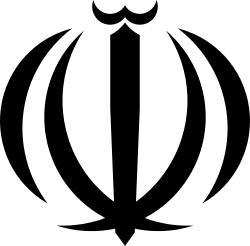Sino-Persian relations
 | |
Iran |
China |
|---|---|
Sino-Persian relations (Chinese: 中国-波斯关系, Pinyin: Zhōngguó-Buōsī guānxì, Persian: روابط ایران و چین) refers to the historic diplomatic, cultural and economic relations between the cultures of China proper and Greater Iran, dating back to ancient times, since at least 200 B.C. The Parthians and Sassanid empires (occupying much of present Iran and Central Asia) had various contacts with the Han and Tang Dynasty empires occupying what is now the People's Republic of China. The two ancient civilizations of Asia were further connected, both economically and culturally, via the Silk Road, for many centuries.
Loanwords
Mainly through trade on the Silk Road was it that Middle Persian words for exotic commodities were loaned into Chinese. Oddly, these loanwords are typically themselves loans from a pre-Iranian substrate, e.g. Elamite or BMAC:[1][2][3]
| Term | Chinese | Pinyin | Persian equivalent | Etymologies |
|---|---|---|---|---|
| lion | 獅/狮 | shī | شیر šīr | |
| alfalfa | 苜蓿 | mù-xū | buksuk | MChin mḭuk-sḭuk |
| grape | 葡萄/蒲桃 | pú táo | باده bāde ‘wine, must’ < MPers bādag | MChin buo-dâu < LHan Chin bɑ-dɑu < Bactrian *bādāwa |
| pomegranate | (安)石榴 | (ān) shí líu | آرتساخ arsak | MChin .ân-źḭäk-lḭəu (< -lḭog) < *anārak; cf. Sogdian n’r’kh (nāraka) |
| amber | 琥珀 | hǔpò | کهربا kahrobā < MPers kah-rubāy | MChin xuoB-pʰɐk, or rather from southwestern Asiatic *χarupah |
| wolfberry | 枸杞 | gǒuqǐ | گوجه gojeh ‘plum, greengage’ | |
| suona | 嗩吶 | suǒnà | سورنا sornāy | |
| cup | 盞/盏 | zhǎn | جام jam | Though likely related, it is unknown which one was derived from the other. |
Relations
Parthian era

The Chinese explorer Zhang Qian, who visited the neighbouring countries of Bactria and Sogdiana in 126 BCE, made the first known Chinese report on Parthia. In his accounts Parthia is named "Ānxī" (Chinese: 安息), a transliteration of "Arsacid", the name of the Parthian dynasty. Zhang Qian clearly identifies Parthia as an advanced urban civilization, which he equates to those of Dayuan (in Ferghana) and Daxia (in Bactria).
- "Anxi is situated several thousand li west of the region of the Great Yuezhi (in Transoxonia). The people are settled on the land, cultivating the fields and growing rice and wheat. They also make wine out of grapes. They have walled cities like the people of Dayuan (Ferghana), the region contains several hundred cities of various sizes. The coins of the country are made of silver and bear the face of the king. When the king dies, the currency is immediately changed and new coins issued with the face of his successor. The people keep records by writing on horizontal strips of leather. To the west lies Tiaozi (Mesopotamia) and to the north Yancai and Lixuan (Hyrcania)." (Shiji, 123, Zhang Qian quote, trans. Burton Watson).
Following Zhang Qian's embassy and report, commercial relations between China, Central Asia, and Parthia flourished, as many Chinese missions were sent throughout the 1st century BCE: "The largest of these embassies to foreign states numbered several hundred persons, while even the smaller parties included over 100 members… In the course of one year anywhere from five to six to over ten parties would be sent out." (Shiji, trans. Burton Watson).
The Parthians were apparently very intent on maintaining good relations with China and also sent their own embassies, starting around 110 BC: "When the Han envoy first visited the kingdom of Anxi (Parthia), the king of Anxi dispatched a party of 20,000 horsemen to meet them on the eastern border of the kingdom… When the Han envoys set out again to return to China, the king of Anxi dispatched envoys of his own to accompany them… The emperor was delighted at this." (Shiji, 123, trans. Burton Watson).
Parthians also played a role in the Silk Road transmission of Buddhism from Central Asia to China. An Shih Kao, a Parthian nobleman and Buddhist missionary, went to the Chinese capital Luoyang in 148 CE where he established temples and became the first man to translate Buddhist scriptures into Chinese.
Sasanian era
Like their predecessors the Parthians, the Sasanian Empire maintained active foreign relations with China, and ambassadors from Persia frequently travelled to China. Chinese documents record thirteen Sasanian embassies to China. Commercially, land and sea trade with China was important to both the Sasanian and Chinese Empires. Large numbers of Sasanian coins have been found in southern China, confirming maritime trade.
On various occasions, Sasanian kings sent their most talented Persian musicians and dancers to the Chinese imperial court. Both empires benefited from trade along the Silk Road, and shared a common interest in preserving and protecting that trade. They cooperated in guarding the trade routes through central Asia, and both built outposts in border areas to keep caravans safe from nomadic tribes and bandits.
During the Liang Dynasty in China, in 547 a Persian embassy paid tribute to the Liang, amber was recorded as originating from Persia by the Liang Shu (Book of Liang).[4]
There are records of several joint Sasanian and Chinese efforts against their common Hephtalite enemy. Following encroachments by the nomadic Turkic on states in Central Asia, an apparent collaboration between Chinese and Sasanian forces repelled the Turkic advances. Documents from Mount Mogh also note the presence of a Chinese general in the service of the king of Sogdiana at the time of the Arab invasion.
Following the invasion of Iran by Muslim Arabs, Peroz III, the son of Yazdegerd III, escaped, along with a few Persian nobles and took refuge in the Chinese imperial court.[5] Both Peroz and his son Narsieh (Chinese neh-shie) were given high titles at the Chinese court.[5] At least on two occasions, the last possibly in 670, Chinese troops were sent with Peroz to restore him to the Sasanian throne, with mixed results. One possibly ended up in a short rule of Peroz in Sistan (Sakestan) from which a little numismatic evidence remains. Narsieh later attained the position of commander of the Chinese imperial guards and his descendants lived in China as respected princes.[5]
Islamic era

After the Islamic conquest of Persia, Persia continued to flourish during the Islamic Golden Age, and its relations with China continued. In 751, the Abbasid Caliphate, which ruled Persia, was in dispute with the Tang Dynasty of China over the control of the Syr Darya region during the Battle of Talas. The commander of the Abbasid army was Zayid ibn Salih, a Persian, and the commanders of the Tang army were Gao Xianzhi, a Goguryo Korean, alongside Li Siye and Duan Xiushi, both Chinese. After the Abbasids won the battle, relations improved, and there were no more conflicts between China and the Persians.
A large number of Central Asian and Persian soldiers, experts, and artisans were recruited by the Mongol Yuan Dynasty of China. Some of them, known as semu ("assorted officials") occupied important official posts in the Yuan state administration.[6] One of the most famous settlers from Persia was Sayyid Ajjal Shams al-Din Omar, who is identified as an ancestor of many Chinese Hui lineages and that of Yunnan's Panthay Hui population. His most famous descendant was Zheng He, who became the Ming dynasty's most famous explorer.
Relations continued during the Ming dynasty.
The famous Maragheh observatory in Maragheh, Iran, is also known to have had some Chinese astronomers working there alongside Iranian astronomers, and some Iranian astronomical instruments were also being used by astronomers in China.[7] Safavid Iranian art was also partly influenced by Chinese art to an extent. Shah Abbas had hundreds of Chinese artisans in his capital Esfahan. Also, 300 Chinese potters produced glazed tile buildings, and hundreds of others produced metalwork, miniature paintings, calligraphy, glasswork, tile work, and pottery.[8][9] From E. Sykes's "Persia and Its People": "Early in the seventeenth century, Shah Abbas imported Chinese workmen into his country to teach his subjects the art of making porcelain, and the Chinese influence is very strong in the designs on this ware. Chinese marks are also copied, so that to scratch an article is sometimes the only means of proving it to be of Persian manufacture, for the Chinese glaze, hard as iron, will take no mark."[10][11]
Of the Chinese Li family in Quanzhou, Li Nu, the son of Li Lu, visited Hormuz in Persia in 1376, married a Persian or an Arab girl, and brought her back to Quanzhou. Li Nu was the ancestor of the Ming Dynasty reformer Li Chih.[12][13]
People's Republic of China and Islamic Republic of Iran
Diplomatic links between China and Iran have been maintained into the 20th and 21st centuries with the formation of both the People's Republic of China and the Islamic Republic of Iran, in 1949 and 1979 respectively.
See also
Notes
- ↑ Miao, Ruiqin (December 2005), "Loanword Adaptation in Mandarin Chinese: Perceptual, Phonological and Sociolinguistic Factors" (PDF), Doctoral Dissertation, Stony Brook University, archived from the original (PDF) on 18 July 2010
- ↑ Feng, Zhiwei (March 2004), "The Semantic Loanwords and Phonemic Loanwords in Chinese Language" (PDF), 11th International Symposium of NIJLA, Tokyo: 200–229, archived from the original (PDF) on 12 November 2012
- ↑ Zha, Zheng-sheng, "Language Contact", Chinese 352: Aspects of Chinese Language, archived from the original on 17 July 2009
- ↑ Fishberg, Maurice (1907). Materials for the physical anthropology of the eastern European Jews, Issues 1-6 (reprint ed.). New Era Print. Co. p. 233. Retrieved 12 June 2011.
- 1 2 3 A History of Chinese civilization, Jacques Gernet.
- ↑ Dillon 1999, pp. 19–21
- ↑ van Dalen, Benno (2002), "Islamic Astronomical Tables in China: The Sources for Huihui li", in Ansari, S. M. Razaullah, History of Oriental Astronomy, Springer Science+Business Media, pp. 19–32, ISBN 978-1-4020-0657-9
- ↑ McDougal Littel, WORLD HISTORY: PATTERNS OF INTERACTION, New York edition, ISBN 978-0-618-91330-5, ISBN 978-0-618-91330-5, Pages 514–515
- ↑ Newman, Andrew J. (2006), "Monumental Challenge and Monumental Responses: the reign of Abbas I (1587–1629)", Safavid Iran: rebirth of a Persian empire, I. B. Tauris, p. 69, ISBN 978-1-86064-667-6
- ↑ Pearce, Francis Barrow (1920). Zanzibar the island metropolis of eastern Africa. Great Britain: Dutton. p. 359. Retrieved 12 March 2012.
Interest to quote the following extract from E. Sykes's Persia and Its People: "Early in the seventeenth century, Shah Abbas imported Chinese workmen into his country to teach his subjects the art of making porcelain, and the Chinese influence is very strong in the designs on this ware. Chinese marks are also copied, so that to scratch an article is sometimes the only means of proving it to be of Persian manufacture, for the Chinese glaze, hard as iron, will take no mark."
- ↑ Pearce, Francis Barrow (1920). Zanzibar the island metropolis of eastern Africa. Great Britain: Dutton. p. 430. Retrieved 12 March 2012.
Shah Abbas, 202; his name mentioned on bronze guns at Zanzibar, 200; imports Chinese artisans to teach the art of pottery-making, 350
- ↑ Association for Asian studies (Ann Arbor;Michigan) (1976). A-L, Volumes 1-2. Columbia University Press. p. 817. ISBN 978-0-231-03801-0. Retrieved 29 June 2010.
- ↑ Chen, Da-Sheng. "CHINESE-IRANIAN RELATIONS vii. Persian Settlements in Southeastern China during the T'ang, Sung, and Yuan Dynasties". Encyclopedia Iranica. Archived from the original on 8 December 2010. Retrieved 28 June 2010.
References
- Dillon, Michael (1999), China's Muslim Hui community: migration, settlement and sects, Routledge, ISBN 978-0-7007-1026-3
- Lipman, Jonathan Neaman (1997), Familiar strangers: a history of Muslims in Northwest China, University of Washington Press, ISBN 978-962-209-468-0
- http://www.iranian.com/main/2010/aug/china-and-iran- Article by Nabil Rastani
Further reading
- John W. Garver. China And Iran: Ancient Partners in a Post-imperial World. 2006. ISBN 978-0-295-98631-9
- "Persian language in Xinjiang" (زبان فارسی در سین کیانگ). Zamir Sa'dollah Zadeh (دکتر ضمیر سعدالله زاد ه). Nameh-i Iran (نامه ایران) V.1. Editor: Hamid Yazdan Parast (حمید یزدان پرست). ISBN 978-964-423-572-6 Perry-Castañeda Library collection under DS 266 N336 2005.
- John Keefer Douglas, Matthew B. Nelson, and Kevin Schwartz; "Fueling the Dragon's Flame: How China's Energy Demands Affect its Relationships in the Middle East." United States-China Economic and Security Review Commission, October 2006.
External links
Historical
- China and Iran | Iranian.com- Article by Nabil Rastani
- "Iran in Central Asia"
- The Sassanids in China
- Chinese-Iranian relations
- Chinese-Iranian relations i. In Pre-Islamic Times
- THE LAST SASANIANS IN CHINA
- For more on Iranian-Chinese relations in history see Encyclopædia Iranica p. 424–460.
Modern
- "Iran's New Alliance With China Could Cost U.S. Leverage". By Robin Wright, Washington Post Staff Writer, Wednesday, 17 November 2004; Page A21
- Chinese Arms Transfers to Iran
- Photos of Jiang Zemin at Persepolis
.svg.png)
